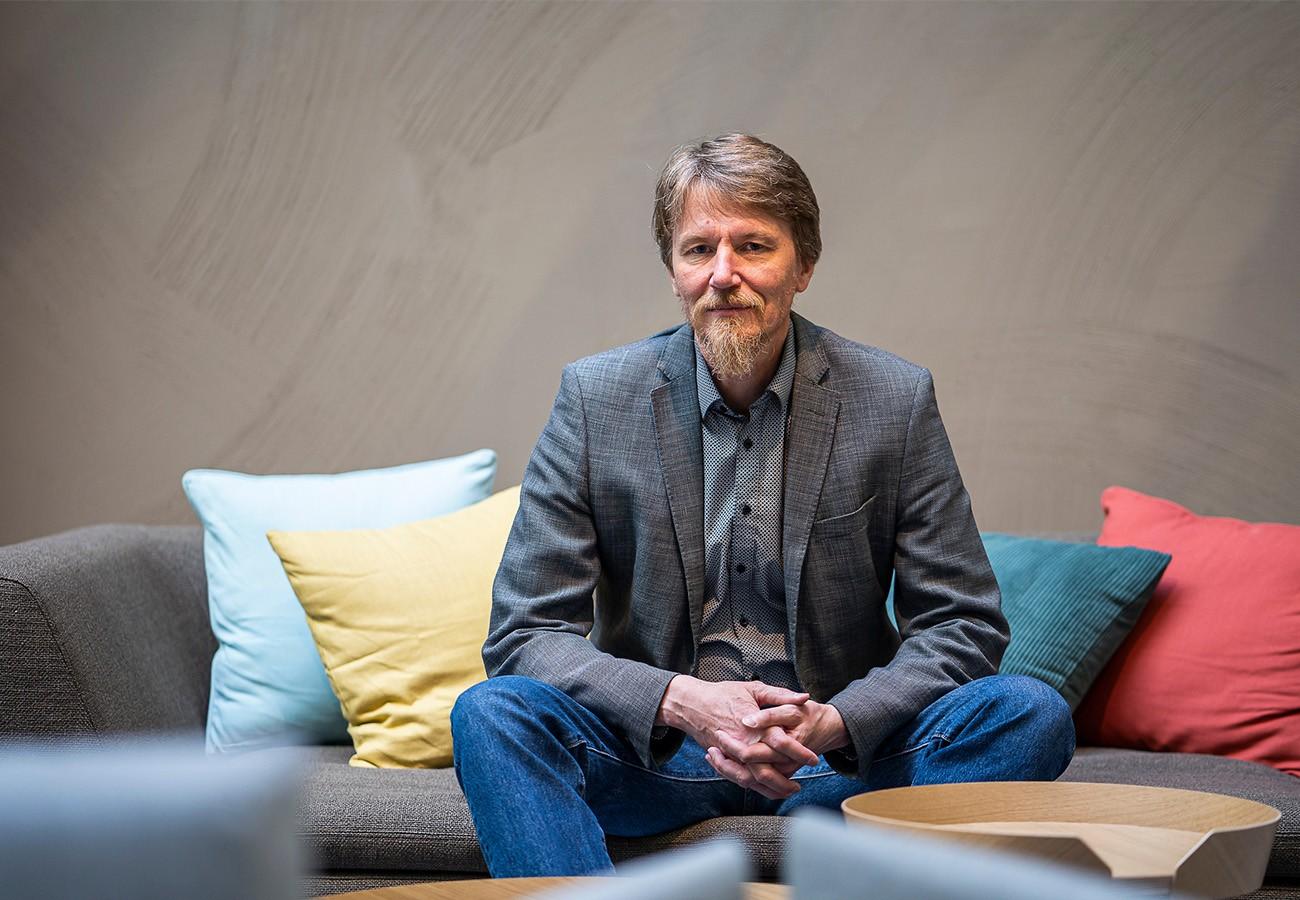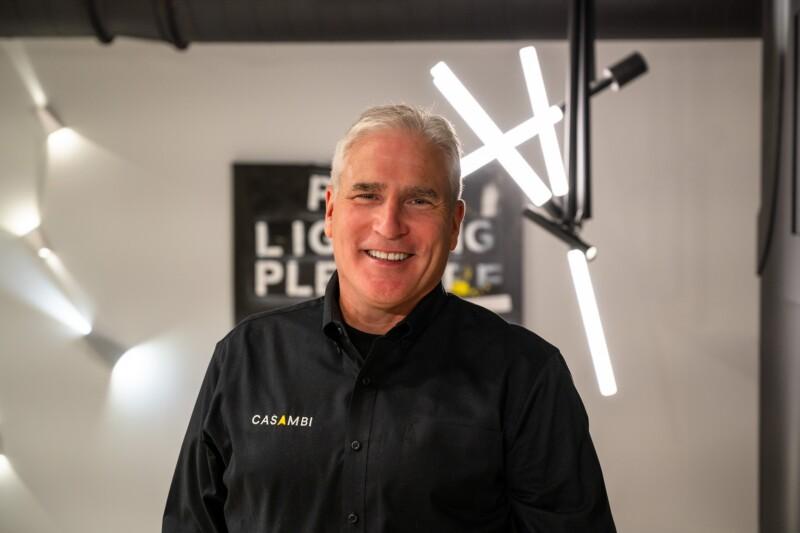Software-driven approach to standardization matter of necessity
 Timo Pakkala co-founded Casambi in 2011. Within a decade the company has grown from start-up to a business widely acknowledged to be the industry’s leading wireless lighting control platform.
Timo Pakkala co-founded Casambi in 2011. Within a decade the company has grown from start-up to a business widely acknowledged to be the industry’s leading wireless lighting control platform.
Standardizing the Bluetooth Audio application layer was relatively simple. There was an assumption that the same game-changing move could be achieved for LED lighting control. This hasn’t been the case. Casambi Founder, Timo Pakkala, gives his view on wireless standards.
Evolution of Music
When the smartphone became the most powerful user interface in the world, standardizing communication between this ubiquitous device and external speakers was a natural evolution for music. It made sense. After all, music is inherently communal. It’s woven into the fabric of society.
Indeed, the most successful of the application-layer standards are the Bluetooth Audio standards, through which you can connect nearly any mobile phone to nearby audio devices to play music. It was the product of collaboration between silicon players, stack developers, component, and end-product companies and enabled global multi-vendor interoperability to achieve the desired functionality: the ability to play and stop a song – on top of which richer, proprietary user applications with bespoke functionality now sit, such as Spotify and Apple Music.
Bluetooth is by far the most recognized wireless standard for audio streaming, with an estimated 1.1 billion devices shipped in 2020. Bluetooth Low Energy Audio is boosting this number, with wireless earbuds as the main contributor. In fact, growth forecasts predict that more than six billion Bluetooth-enabled devices will ship annually by 2025. Furthermore, Bluetooth Low Energy (BLE) is projected to have a decisive impact on the market with 96% of all Bluetooth-enabled devices forecast to include Low Energy by the same year.
While you can standardize the medium, you can’t ever standardize what kind of music people will make and how loud their listeners might wish to play it. Because that’s about taste. The same can be said of lighting control.
We’re undergoing a comparatively slower LED revolution. But a revolution it is, nonetheless. The transition from legacy light sources to digitized LED versions is still underway. According to Statista, the LED penetration rate of the worldwide lighting market currently sits somewhere just above the 50% mark. And the advent of pervasive wireless protocols such as BLE is liberating lighting systems from the physical constraints of wiring. This is opening the doors to networked lighting for bespoke, personalized, and highly flexible light-level management.
You want to be able to tune LEDs as you can tune music volume. Sticking with on/off lighting is such a wasted opportunity. But standardizing the music player application layer was relatively simple and I think there was an assumption that the same could be achieved for LED lighting control. This hasn’t been the case.
A religious stance on standards
Actors in the wireless game hold passionate and sometimes polarized views on standardization. There are a lot of people who think standards are good and proprietary is bad. These concerns incorporate the fear that if something’s not adhering to a standard, one is at risk of single vendor lock-in or falling prey to premature obsolescence.
In the lighting field, the reason is related to worry that products won’t work together. On the communication layer, standards are extremely helpful. They enable interoperability. But when you start delving into and standardizing the more complex areas like in the application layers, you start restricting innovation.
In a standard-based lighting ecosystem, the chips that go inside the devices deployed in a network generally come from multiple vendors. Although they may run on a standardized protocol that is intended to enable the same communication, all the chips are different. They likely operate on different runtime resources. They likely have different limitations. When working with multiple vendors, it is important to be aware of the pitfall of having multiple versions of the firmware within a network. The whole system will be limited by the capabilities of the weakest/oldest device in use within the ecosystem.
Conversely, in a proprietary system, everything comes from one single vendor, so all resources are the same. However, in this scenario, a lighting designer may feel extremely limited when it comes to picking the luminaires, the drivers, sensors, or switches from one single vendor to make sure everything works seamlessly together.
Openness – as a characteristic – is proven to enhance innovation and accelerate transformation for the benefit of all. At Casambi, our strategy is predicated on this notion. We bring together the best of both these two worlds. And successfully so. The vast array of Casambi Ready products available on the market brings scale and choice to lighting projects in a way that proprietary solutions from a single vendor cannot. And they work together much better than standardized ones because we’ve taken a software-driven approach to standardization. I strongly believe this is the way to go.
A software-driven approach to standardization
When it comes to hardware products, Casambi holds a very strong market position. There are essentially two stages to adding Casambi functionality to luminaires. Select a Casambi Ready luminaire from ecosystem partners, which ensures out-of-the-box interoperability in terms of connectivity and performance. Or choose luminaires with integral drivers, decorative fixtures with LED lamps, or other devices and give them Casambi connectivity using Casambi’s CBU devices (white modules). Through this approach, Casambi has achieved a critical mass: Today, the Casambi Ecosystem contains thousands of Casambi Ready products and the company cooperates with over 200 luminaire manufacturers around the world.
Casambi has standardized the brains of the ecosystem around state-of-the-art BLE chips from market leader, Nordic Semiconductor, and the firmware comes from a single vendor – Casambi. This guarantees that the physical infrastructure inside all control devices, regardless of brand, is the same. A specifier has the freedom to choose their control devices from an extensive list of vendors. Casambi remotely and safely updates devices in the field with the latest software and firmware. Over-the-Air programming allows us to push new software features and additional functionality out to the entire fleet of installed devices at once.
Casambi is sometimes perceived as somehow against standards. But this is not the case at all. We’re fully compliant with Bluetooth 5.3. And we’re fully committed to supporting key industry standards such as DALI, DALI2, the D4i data standard, and EnOcean’s energy harvesting switches. We offer industry-leading wireless DALI support. Our DALI gateway enables wired installations to be easily expanded wirelessly. In this scenario, one can enjoy all the benefits and flexibility conferred by wireless Casambi networks and keep all the DALI functions and controls in use. We recently joined the Matter alliance as a participant member too.
We decided to use only the communication layer of the Bluetooth stack. Our technology forms a mesh network (‘Casambi Mesh’), which enables encrypted device-to-device communication inside a lighting network. BLE is used for communication between a mobile phone (or the control device) and the Casambi platform.
Casambi is proprietary in the very loosest sense of the word. Because of the critical mass achieved, by proxy, it’s becoming the de facto ‘standard’. I attribute a great proportion of this success to having taken the software-driven approach.
Why?
Because life and markets evolve.
The key point with software is that you can constantly change it, improve it, and enhance it. Casambi can dynamically update the system in the field. This means that we can keep enhancing the system and keep all units interoperable. We can be sure that all the units in the network have the latest and best version of the firmware. It’s this software-driven mechanism that allows for constant and fast evolution, reacting to real market needs.
In this sense, I feel that standards-based solutions do not currently take full advantage of the modern capabilities of software. The traditional approach involves painful negotiation toward a finalized standard, with multiple parties agreeing to the lowest common denominator. This often results in a standard that is not overly advantageous to anybody.
Implementing complex software-based systems is extremely difficult, let alone standardizing them. It’s difficult to get just one party’s solution to work well and be relatively bug-free. If you have many companies all trying to interpret a standard and then hoping that their products will work together…. It’s a slow, painful, risky, and arduous journey based on wishful thinking.
This software-driven approach is the biggest reason why you do not see so many successful standards in the application layer. You don’t see people standardizing on Android or iOS. There’s one company who is driving those and there is one implementation that the others use as well. That’s why it is a fundamentally better, more efficient process to evolve a system based on real market needs.
Because life and markets evolve, a software-driven approach is the way to go. People can and should be able to innovate on different layers of the Bluetooth stack. Pick the parts of the standard that they need and innovate on the others.
Casambi joins Matter
Last month, Casambi announced its membership in the Connectivity Standards Alliance, officially backing the new Matter Standard. Matter is a global IoT connectivity standard in development that will build on top of existing IP connectivity protocols (namely wi-fi, and Thread, and will use Bluetooth for commissioning) to enable cross-platform IoT communication. Its objective is to deliver reliable and secure connections across smart home devices, platforms, and ecosystems.
Anticipated to become the most significant standard for the Smart Home market, Matter is supported by many big names in the field including Amazon, Apple, Comcast, and Google – who have all decided to unify. Because they all have their own Smart Home systems, there’s a lot of collective experience behind the alliance. The standard is also being crafted in the most practical and software-driven way.
Matter is not a standard in the traditional sense. It’s an open-source, royalty-free standard. Typically, a standard is a written document, and you pray that people interpret it in the way it was intended. But in the case of Matter, each of the participating companies is bringing its own code to the table, and co-developing open-source implementation for various platforms, from Linux to Windows, to Android. It is anticipated to become so significant in the Smart Home space that in a couple of years it will be impossible to sell any products that aren’t Matter supported.
As a standard, Matter will boost the whole Smart Home concept – for which, interoperability has been suboptimal. In many respects, Casambi is the furthest along in having a modern wireless smart lighting control system. We have an excellent solution not only for bulbs but also for integrated LED fixtures. We can support any fixture out there. And with Matter, we will co-exist nicely with our ‘competitors’.
Our joining the CSA to back Matter will greatly impact our partners: If they have a Casambi-enabled fixture, it will also become a Matter-capable fixture. They don’t need to do anything … we unlock the doors for our partners and through Matter will bring a lot more benefits to the Casambi Ecosystem. When Matter launches, we’d like to be one of the first to leverage it, advancing Smart Lighting Control for the benefit of all Casambi partners and the industry at large.
The future will see an increasing focus on software, user interfaces, and deeper integration with third-party systems. Matter will provide a shared foundation on which to build an application for connecting devices but will also afford developers the freedom to innovate on the user application level above. As someone who believes in the software-driven approach to standardization, this, indeed, is music to my ears.
Interested in learning more about Casambi? Drop us a note, and we’ll reach out to you:


